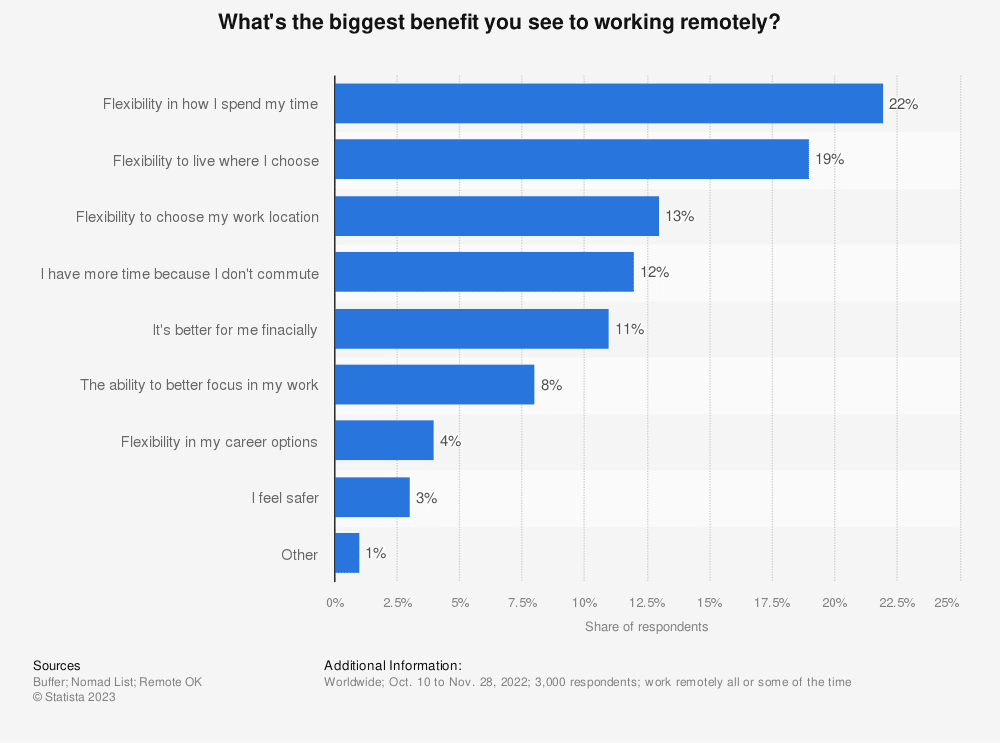The rise of remote and hybrid work models has reshaped the way organizations operate and manage their workforces. Along with these changes, managers and HR professionals have recognized the need for more adaptable and employee-centric leave management strategies. In this article, we will explore the changing nature of work, the challenges of leave management in remote and hybrid settings, and best practices for effective leave management.
The Changing World of Work
The traditional 9-to-5 office job has given way to a more flexible and diverse work environment. Remote work, where employees work from locations outside the office, has become increasingly common. Hybrid work, which combines both remote and in-office work, has also gained popularity. This shift is in response to the COVID-19 pandemic as well as evolving expectations. Employees increasingly desire the flexibility to work from home or adopt hybrid work models, as evidenced in the chart below:
Remote and Hybrid Work Statistics
The adoption of remote and hybrid work models has been on the rise:
- According to Forbes, 12.7% of the U.S. workforce is working remotely full-time as of 2023.
- Upwork predicts that 32.6 million Americans will work remotely by 2025, which is about 22% of the workforce.
- A Bankrate survey found that 64% of employees would prefer a full-time remote schedule, and 68% would prefer a hybrid schedule as opposed to a full-time in-office schedule.
The Importance of Effective Leave Management
When it comes to your workforce, effective leave management is crucial for several reasons:
- Retention of Quality Workers: Employees value flexibility and work-life balance. Offering robust leave management practices can attract and retain top talent.
- Increased Productivity: Well-managed leave policies help maintain a healthy work-life balance, which, in turn, leads to increased employee productivity and engagement.
- Enhanced Employee Morale: Employees appreciate when their employers prioritize their well-being. Effective leave management contributes to higher employee morale and job satisfaction..
Leave Management Challenges in Remote and Hybrid Settings
Remote and hybrid work models present unique challenges for leave management:
- Communication and Accessibility: Effective communication and accessibility to leave policies and procedures are vital when employees are not physically present in the office.
- Employee Well-being and Burnout: Monitoring employee well-being, preventing burnout, and promoting mental health become essential when remote workers might experience isolation or blurred work-life boundaries.
- Global Time Zone Differences: In a remote or hybrid workforce spanning different time zones, coordinating leave schedules and approvals can become complex.
- Documentation and Compliance: Ensuring proper documentation of leave requests and compliance with labor laws can be more challenging when managing remote and hybrid teams.
- Tracking Remote Work Equipment: In remote work scenarios, tracking the use of company equipment during leave periods is crucial to prevent loss or misuse.
- Communication Fatigue: Constant digital communication in remote work settings can lead to communication fatigue, affecting the clarity and effectiveness of leave-related discussions.
Leave Management Best Practices
To address these challenges, consider the following leave management best practices:
- Transparent Leave Policies: Clearly communicate leave policies and expectations to all employees, including remote and hybrid workers.
- Clear Guidelines and Procedures: Develop and document clear guidelines and procedures for requesting and approving leave.
- Equitable Policies for All Employees: Ensure that leave policies are equitable, regardless of an employee’s work location or model.
- Streamlined Request and Approval Process: Implement a streamlined process for requesting and approving leave, minimizing administrative burdens.
- User-Friendly Leave Request Systems: Utilize user-friendly leave request systems that are accessible to all employees, even those working remotely.
- Quick and Efficient Approvals: Ensure that leave approvals are processed promptly to avoid delays and disruptions to work.
- Accurate Leave Tracking: Maintain accurate records of employee leave balances and history.
- Automated Tracking Tools: Consider automated leave tracking tools to reduce manual data entry and errors.
- Real-Time Updates: Provide real-time updates to employees regarding their leave balances and approvals.
- Employee Engagement and Well-being: Promote employee engagement and well-being by encouraging time off and providing mental health support.
Technology Solutions for Leave Management
The Role of Leave Management Software
Leave management software plays a pivotal role in streamlining and optimizing leave processes. It offers the following advantages:
- Centralized Data and Reporting: Leave management software centralizes all leave data, making it easily accessible and providing robust reporting capabilities.
- Efficiency: Automation reduces the time and effort required for leave management tasks, such as request processing and tracking.
- Accuracy: Automated calculations reduce the risk of errors in leave accruals and balances.
In Conclusion
The future of leave management in remote and hybrid workforces is closely tied to efficient and employee-centric practices. As organizations continue to adapt to changing work models, implementing best practices and leveraging technology solutions like Time Off Cloud can help ensure that leave management remains a seamless and integral part of the modern workplace.
Why Choose Time Off Cloud?
Time Off Cloud is a leading leave management software that offers a range of features and benefits:
- Efficient Leave Management: Time Off Cloud streamlines the leave request and approval process, making it quick and easy for both employees and managers.
- Centralized Data: All leave data is stored in a centralized system, providing real-time visibility and accurate tracking.
- Customizable Policies: Time Off Cloud allows organizations to customize leave policies to align with their unique needs and requirements.
- Reporting and Analytics: Robust reporting and analytics tools help organizations gain insights into leave trends and patterns.
- Employee Self-Service: Employees can easily request leave, check their balances, and view their leave history through a user-friendly portal.
Contact Us
If you’re ready to take the next step toward enhancing your leave management processes and supporting your remote and hybrid workforce, we invite you to schedule a demo with Time Off Cloud. Our team is here to answer any questions you may have and provide a personalized demonstration of how our leave management software can transform your organization’s leave management experience. Contact us today.



